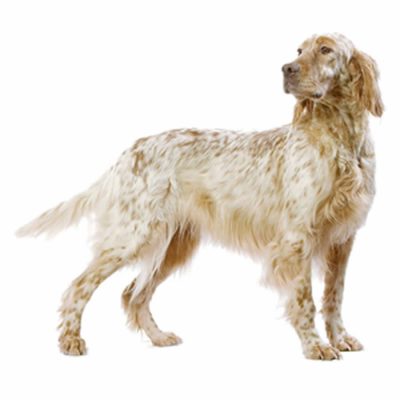English Setter
Group 3: Gun dogs
Height:
Male: 65 – 68 cm
Female: 61 – 65 cm
Energy Level: Moderate
Original Function: Setter
Lifespan: 10 – 14 yrs
Recommended for: Active people & families.

Group 3: Gun dogs
Height:
Male: 65 – 68 cm
Female: 61 – 65 cm
Energy Level: Moderate
Original Function: Setter
Lifespan: 10 – 14 yrs
Recommended for: Active people & families.

The English Setter descends from a variety of Spanish spaniels, the breed was also known as the Laverack Setter, named after Edward Laverack how had a role in developing them. The word “setter” comes from the almost “sitting” position the dog exhibits when he has discovered game.
The English Setter is a vigorous, quick and very quiet worker with an excellent nose. His coat keeps the dog comfortable in both hot and cold weather. The sweet personality of the English Setter and his gentleness with children make him a fine family companion dog.
They are lively, sociable dogs that will announce the arrival of visitors and then treat them as if they have known them all their lives! They are naturally happy with other dogs and household animals. The English Setter’s talents include hunting, tracking, retrieving, pointing, watchdogging and agility.
Appearance: Large sized, clean in outline, elegant in appearance and movement. Oval shaped eyes, normally dark. Ears hang to the side of the head. Tail is long.
Temperament: Intensely friendly and good natured.
Characteristics: Very active with a keen game sense.
Colour: Black and white (blue belton), orange and white (orange belton), lemon and white (lemon belton), liver and white (liver belton) or tricolour, that is blue belton and tan or liver belton and tan, those without heavy patches of colour on body but flecked (belton) all over preferred.
Coat: From back of head in line with ears slightly wavy, not curly, long and silky as is coat generally, breeches and forelegs nearly down to feet well feathered.
Grooming: Need a reasonable amount of grooming and trimming to keep them looking at their best. Regular trimming of the hair between their pads and under their ears is a must. Air must be allowed into their ears to prevent infections. The feathering will need attention now and again. If showing this breed considerably more attention will be required.
Exercise: they need quite a lot of exercise. They do have a tendency to wander so make sure your garden is well fenced.
Health: This breed can suffer from bloat, hip dysplasia and eye problems.